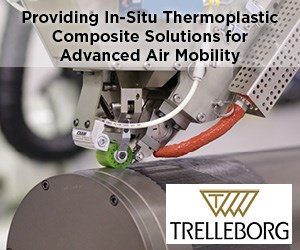PAL-V, NLR complete composite rotors for Liberty flying car
Rotor blade design spans nearly 11 meters in length for flight, with a mid-hinge to fold and accommodate 4-meter vehicle length while driving.
Share
In November 2024 Personal Air Landing Vehicle (PAL-V, Raamdonksveer, Netherlands) and Royal NLR – Netherlands Aerospace Centre (NLR, Amsterdam) successfully completed the development of the rotor blades for the PAL-V Liberty, marking the beginning of flying car’s industrialization phase, and another step closer to serial production.
The rotor blades design was undertaken by NLR. The aerospace research institute’s extensive experience in aerospace engineering and composite structures has been crucial in refining their design and ensuring the blades meet the highest standards of performance and safety. According to NLR, the resulting rotor blades are 20% more efficient with less drag compared to equivalent blades, resulting in better performance and fuel economy. Use of composites means a set of two rotor blades only weighs 35.8 kilograms while spanning nearly 11 meters in length.
PAL-V and NLR have been working closely together to perfect the rotor blades, which are now ready for mass production. PAL-V has set up a small-scale assembly location near its headquarters in the Netherlands, where it is preparing for the serial production of the Liberty.
“We are thrilled to have reached another milestone with our new technology for high-end composite rotor blades,” says Henri de Vries, senior scientist at NLR. “Together with PAL-V we’ve overcome technical challenges and ensured our rotor blades are ready for industrial production. Gyroplane rotor blades are brought in motion by the airflow to create lift instead of using a motor. This is called autorotation. So the PAL-V blades are basically its wings during flight. Next to being lightweight, they contain a mid-hinge to fold the blades and enable driving the vehicle on the road with a convenient vehicle length of just 4 meters.”
NLR’s facilities — which include wind tunnels, composites manufacturing structure testing equipment and even a landing strip — have all been used in the R&D and certification testing of various parts and subsystems of the PAL-V Liberty. The partnership with NLR will continue to play a key role as PAL-V approaches the launch of its first production units.
“With the support of numerous suppliers and esteemed partners like NLR, PAL-V now concentrates on finalizing the last stage of air certification: compliance demonstration,” says Robert Dingemanse, CEO and founder of PAL-V. “With an order book filling the first 3 years of production by a majority of professional customers, as well as private individuals, the PAL-V Liberty will be used to overcome the growing global mobility challenges.”
Related Content
-
Composites end markets: Automotive (2024)
Recent trends in automotive composites include new materials and developments for battery electric vehicles, hydrogen fuel cell technologies, and recycled and bio-based materials.
-
Composites end markets: Aerospace (2023)
With COVID in the past and passengers flying again, commercial aircraft production is ramping up. The aerocomposites supply chain is busy developing new M&P for an approaching next-generation aircraft program.
-
Composites end markets: Pressure vessels (2024)
The market for pressure vessels used to store zero-emission fuels is rapidly growing, with ongoing developments and commercialization of Type 3, 4 and 5 tanks.








